BSBMGT605: Management Leadership Assessment - All Assessment Tasks
VerifiedAdded on 2023/04/23
|43
|10080
|195
Project
AI Summary
This document presents a comprehensive solution to a leadership and management assessment, addressing various aspects of organizational leadership. The assessment tasks cover a wide range of topics, including the concept of business ethics, the importance of ethical leadership in supporting organizational values, and the characteristics and benefits of ethical leaders. It also explores different styles of leadership and their impact on organizational culture, the role of charismatic leaders in implementing a company's vision, and strategies to encourage employee participation in decision-making. Further tasks delve into building trust and confidence with colleagues, ensuring work health and safety compliance, and adhering to anti-discrimination laws. The assessment includes practical elements such as PowerPoint presentations, email communications, and report writing to investigate workplace issues. Additionally, it involves creating a press release, developing work goals, and crafting personal development plans. The final task focuses on ethical considerations, requiring the creation of an ethics memo to promote a positive and inclusive work environment. This resource provides a detailed overview of leadership principles and practical applications within a business context.
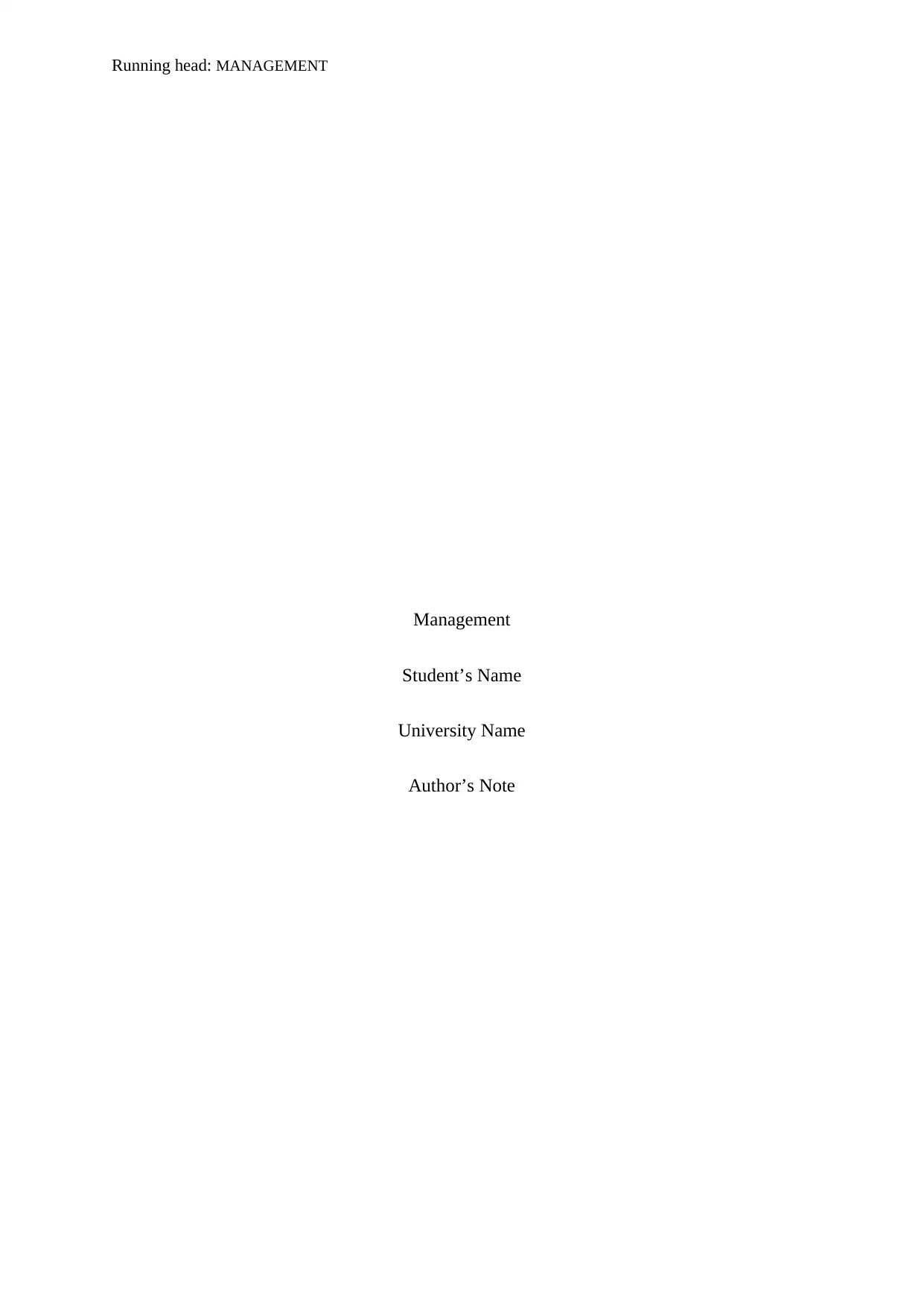
Running head: MANAGEMENT
Management
Student’s Name
University Name
Author’s Note
Management
Student’s Name
University Name
Author’s Note
Paraphrase This Document
Need a fresh take? Get an instant paraphrase of this document with our AI Paraphraser
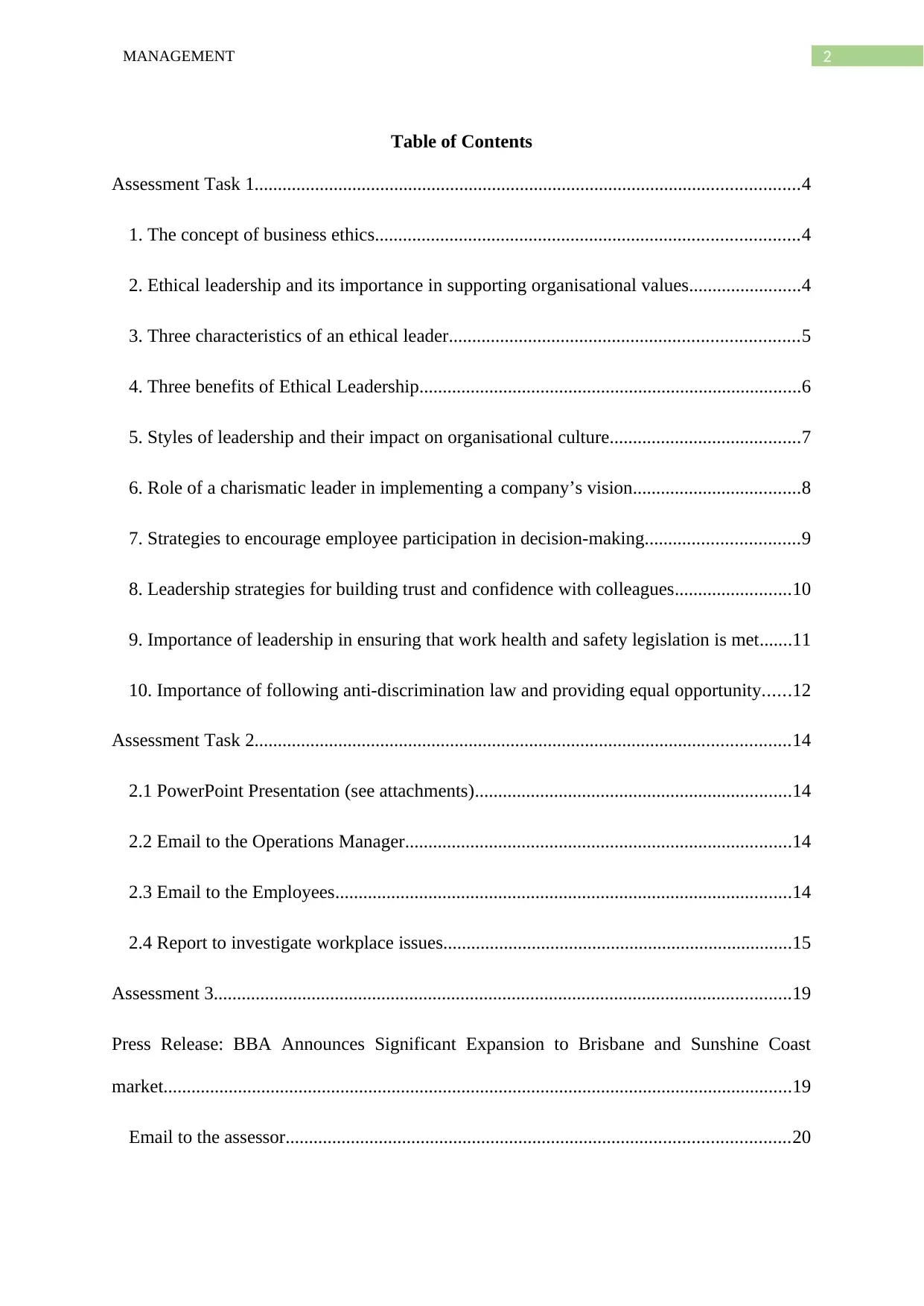
2MANAGEMENT
Table of Contents
Assessment Task 1.....................................................................................................................4
1. The concept of business ethics...........................................................................................4
2. Ethical leadership and its importance in supporting organisational values........................4
3. Three characteristics of an ethical leader...........................................................................5
4. Three benefits of Ethical Leadership..................................................................................6
5. Styles of leadership and their impact on organisational culture.........................................7
6. Role of a charismatic leader in implementing a company’s vision....................................8
7. Strategies to encourage employee participation in decision-making.................................9
8. Leadership strategies for building trust and confidence with colleagues.........................10
9. Importance of leadership in ensuring that work health and safety legislation is met.......11
10. Importance of following anti-discrimination law and providing equal opportunity......12
Assessment Task 2...................................................................................................................14
2.1 PowerPoint Presentation (see attachments)....................................................................14
2.2 Email to the Operations Manager...................................................................................14
2.3 Email to the Employees..................................................................................................14
2.4 Report to investigate workplace issues...........................................................................15
Assessment 3............................................................................................................................19
Press Release: BBA Announces Significant Expansion to Brisbane and Sunshine Coast
market.......................................................................................................................................19
Email to the assessor............................................................................................................20
Table of Contents
Assessment Task 1.....................................................................................................................4
1. The concept of business ethics...........................................................................................4
2. Ethical leadership and its importance in supporting organisational values........................4
3. Three characteristics of an ethical leader...........................................................................5
4. Three benefits of Ethical Leadership..................................................................................6
5. Styles of leadership and their impact on organisational culture.........................................7
6. Role of a charismatic leader in implementing a company’s vision....................................8
7. Strategies to encourage employee participation in decision-making.................................9
8. Leadership strategies for building trust and confidence with colleagues.........................10
9. Importance of leadership in ensuring that work health and safety legislation is met.......11
10. Importance of following anti-discrimination law and providing equal opportunity......12
Assessment Task 2...................................................................................................................14
2.1 PowerPoint Presentation (see attachments)....................................................................14
2.2 Email to the Operations Manager...................................................................................14
2.3 Email to the Employees..................................................................................................14
2.4 Report to investigate workplace issues...........................................................................15
Assessment 3............................................................................................................................19
Press Release: BBA Announces Significant Expansion to Brisbane and Sunshine Coast
market.......................................................................................................................................19
Email to the assessor............................................................................................................20
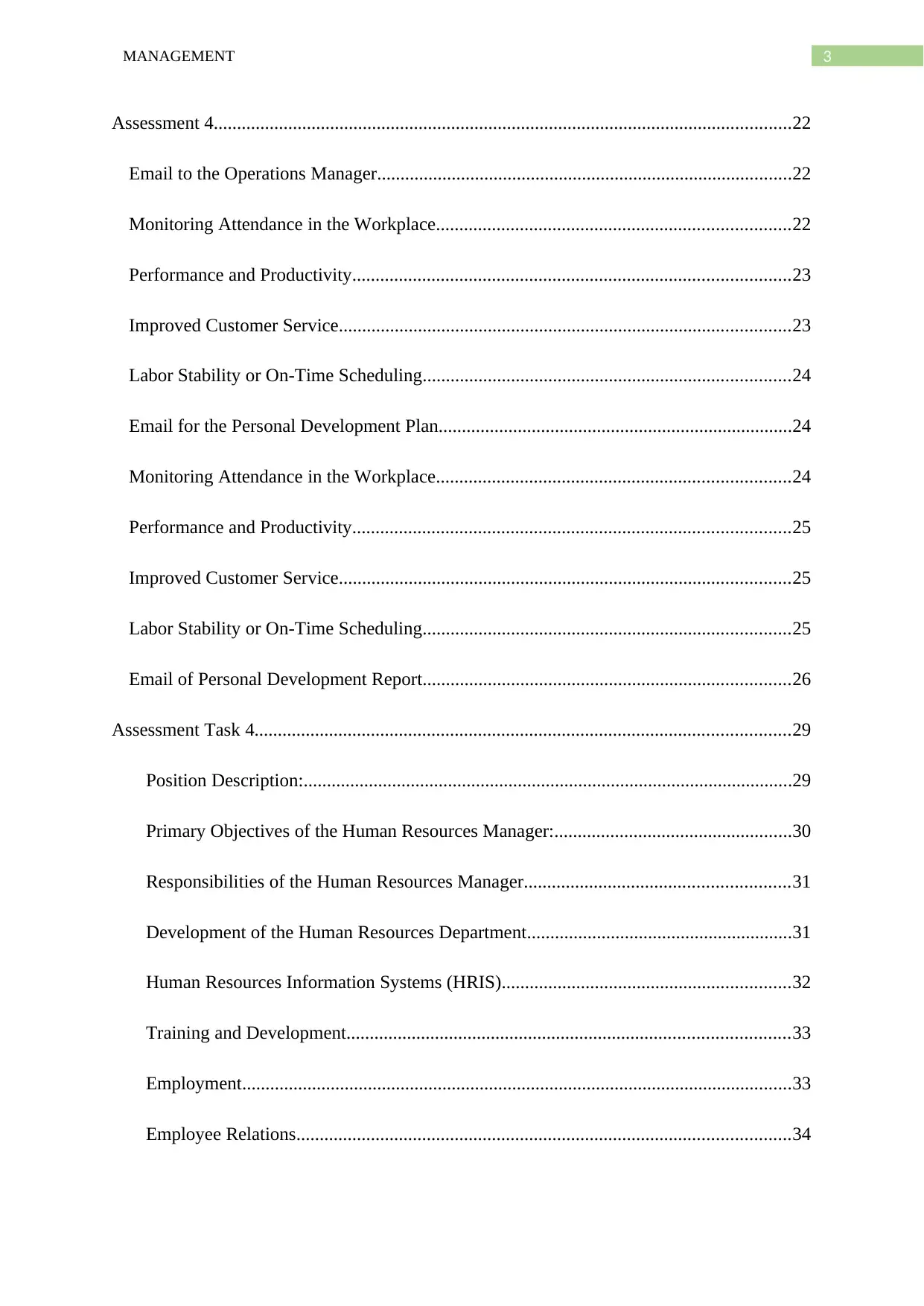
3MANAGEMENT
Assessment 4............................................................................................................................22
Email to the Operations Manager.........................................................................................22
Monitoring Attendance in the Workplace............................................................................22
Performance and Productivity..............................................................................................23
Improved Customer Service.................................................................................................23
Labor Stability or On-Time Scheduling...............................................................................24
Email for the Personal Development Plan............................................................................24
Monitoring Attendance in the Workplace............................................................................24
Performance and Productivity..............................................................................................25
Improved Customer Service.................................................................................................25
Labor Stability or On-Time Scheduling...............................................................................25
Email of Personal Development Report...............................................................................26
Assessment Task 4...................................................................................................................29
Position Description:.........................................................................................................29
Primary Objectives of the Human Resources Manager:...................................................30
Responsibilities of the Human Resources Manager.........................................................31
Development of the Human Resources Department.........................................................31
Human Resources Information Systems (HRIS)..............................................................32
Training and Development...............................................................................................33
Employment......................................................................................................................33
Employee Relations..........................................................................................................34
Assessment 4............................................................................................................................22
Email to the Operations Manager.........................................................................................22
Monitoring Attendance in the Workplace............................................................................22
Performance and Productivity..............................................................................................23
Improved Customer Service.................................................................................................23
Labor Stability or On-Time Scheduling...............................................................................24
Email for the Personal Development Plan............................................................................24
Monitoring Attendance in the Workplace............................................................................24
Performance and Productivity..............................................................................................25
Improved Customer Service.................................................................................................25
Labor Stability or On-Time Scheduling...............................................................................25
Email of Personal Development Report...............................................................................26
Assessment Task 4...................................................................................................................29
Position Description:.........................................................................................................29
Primary Objectives of the Human Resources Manager:...................................................30
Responsibilities of the Human Resources Manager.........................................................31
Development of the Human Resources Department.........................................................31
Human Resources Information Systems (HRIS)..............................................................32
Training and Development...............................................................................................33
Employment......................................................................................................................33
Employee Relations..........................................................................................................34
⊘ This is a preview!⊘
Do you want full access?
Subscribe today to unlock all pages.

Trusted by 1+ million students worldwide
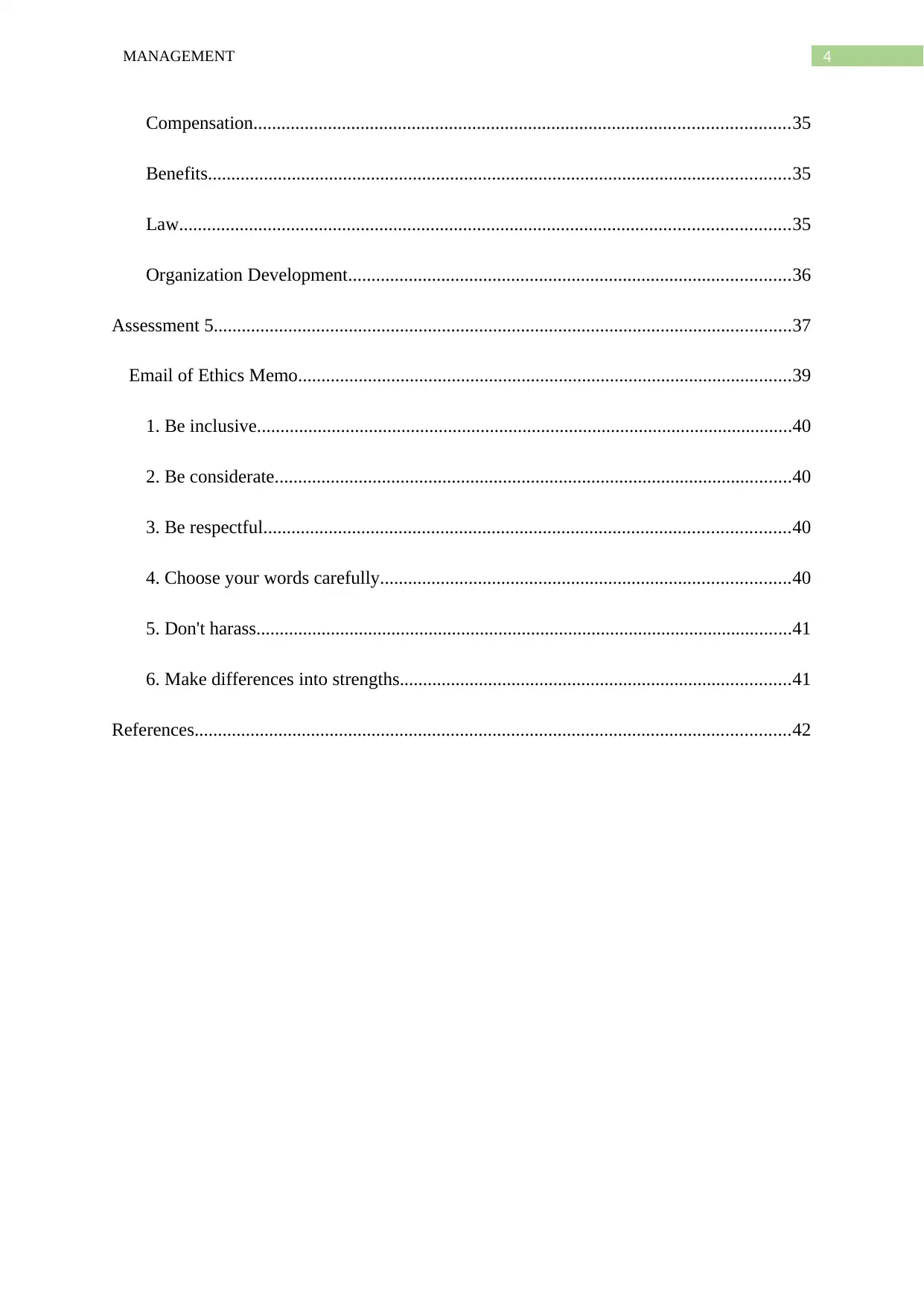
4MANAGEMENT
Compensation...................................................................................................................35
Benefits.............................................................................................................................35
Law...................................................................................................................................35
Organization Development...............................................................................................36
Assessment 5............................................................................................................................37
Email of Ethics Memo..........................................................................................................39
1. Be inclusive...................................................................................................................40
2. Be considerate...............................................................................................................40
3. Be respectful.................................................................................................................40
4. Choose your words carefully........................................................................................40
5. Don't harass...................................................................................................................41
6. Make differences into strengths....................................................................................41
References................................................................................................................................42
Compensation...................................................................................................................35
Benefits.............................................................................................................................35
Law...................................................................................................................................35
Organization Development...............................................................................................36
Assessment 5............................................................................................................................37
Email of Ethics Memo..........................................................................................................39
1. Be inclusive...................................................................................................................40
2. Be considerate...............................................................................................................40
3. Be respectful.................................................................................................................40
4. Choose your words carefully........................................................................................40
5. Don't harass...................................................................................................................41
6. Make differences into strengths....................................................................................41
References................................................................................................................................42
Paraphrase This Document
Need a fresh take? Get an instant paraphrase of this document with our AI Paraphraser
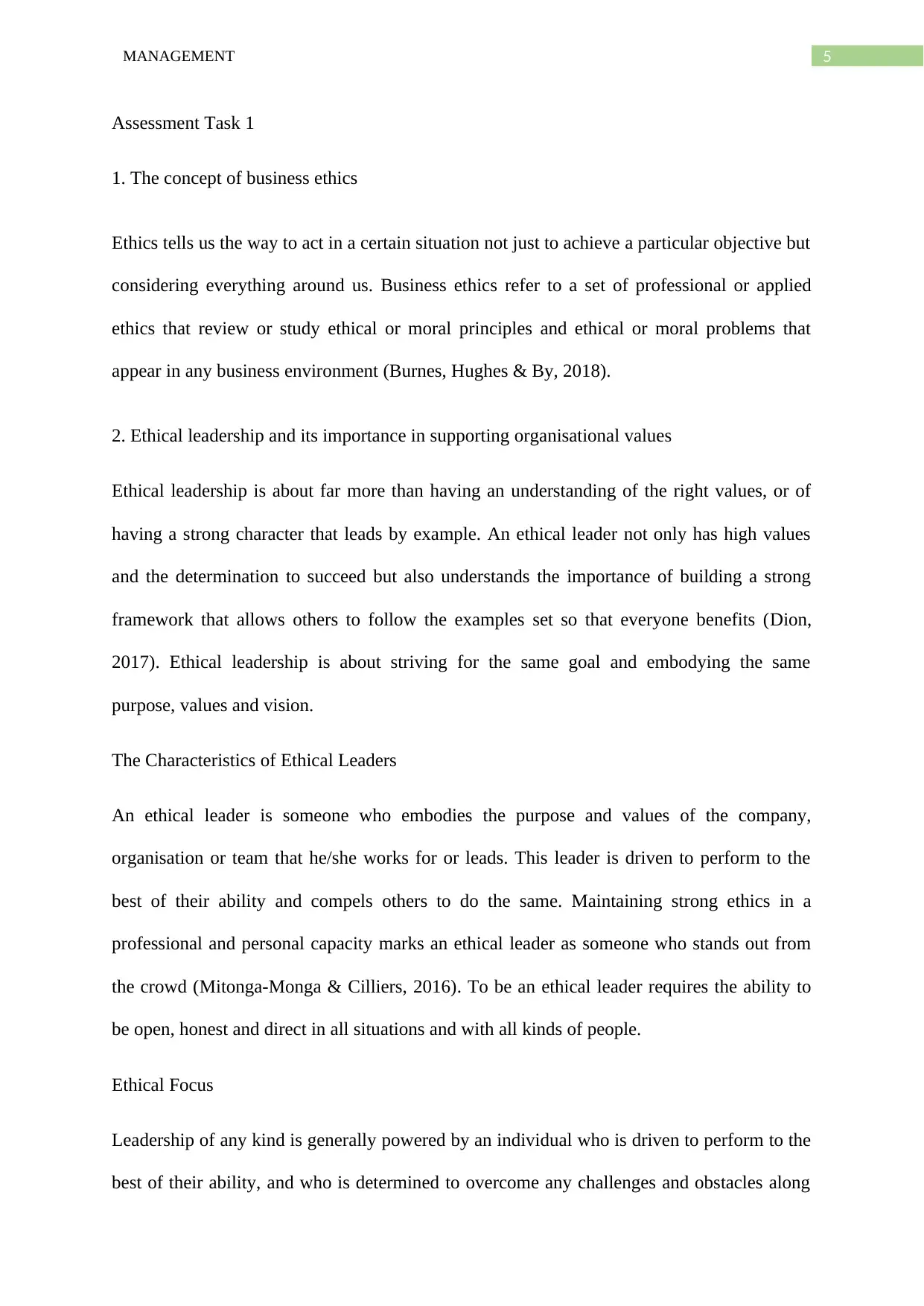
5MANAGEMENT
Assessment Task 1
1. The concept of business ethics
Ethics tells us the way to act in a certain situation not just to achieve a particular objective but
considering everything around us. Business ethics refer to a set of professional or applied
ethics that review or study ethical or moral principles and ethical or moral problems that
appear in any business environment (Burnes, Hughes & By, 2018).
2. Ethical leadership and its importance in supporting organisational values
Ethical leadership is about far more than having an understanding of the right values, or of
having a strong character that leads by example. An ethical leader not only has high values
and the determination to succeed but also understands the importance of building a strong
framework that allows others to follow the examples set so that everyone benefits (Dion,
2017). Ethical leadership is about striving for the same goal and embodying the same
purpose, values and vision.
The Characteristics of Ethical Leaders
An ethical leader is someone who embodies the purpose and values of the company,
organisation or team that he/she works for or leads. This leader is driven to perform to the
best of their ability and compels others to do the same. Maintaining strong ethics in a
professional and personal capacity marks an ethical leader as someone who stands out from
the crowd (Mitonga-Monga & Cilliers, 2016). To be an ethical leader requires the ability to
be open, honest and direct in all situations and with all kinds of people.
Ethical Focus
Leadership of any kind is generally powered by an individual who is driven to perform to the
best of their ability, and who is determined to overcome any challenges and obstacles along
Assessment Task 1
1. The concept of business ethics
Ethics tells us the way to act in a certain situation not just to achieve a particular objective but
considering everything around us. Business ethics refer to a set of professional or applied
ethics that review or study ethical or moral principles and ethical or moral problems that
appear in any business environment (Burnes, Hughes & By, 2018).
2. Ethical leadership and its importance in supporting organisational values
Ethical leadership is about far more than having an understanding of the right values, or of
having a strong character that leads by example. An ethical leader not only has high values
and the determination to succeed but also understands the importance of building a strong
framework that allows others to follow the examples set so that everyone benefits (Dion,
2017). Ethical leadership is about striving for the same goal and embodying the same
purpose, values and vision.
The Characteristics of Ethical Leaders
An ethical leader is someone who embodies the purpose and values of the company,
organisation or team that he/she works for or leads. This leader is driven to perform to the
best of their ability and compels others to do the same. Maintaining strong ethics in a
professional and personal capacity marks an ethical leader as someone who stands out from
the crowd (Mitonga-Monga & Cilliers, 2016). To be an ethical leader requires the ability to
be open, honest and direct in all situations and with all kinds of people.
Ethical Focus
Leadership of any kind is generally powered by an individual who is driven to perform to the
best of their ability, and who is determined to overcome any challenges and obstacles along
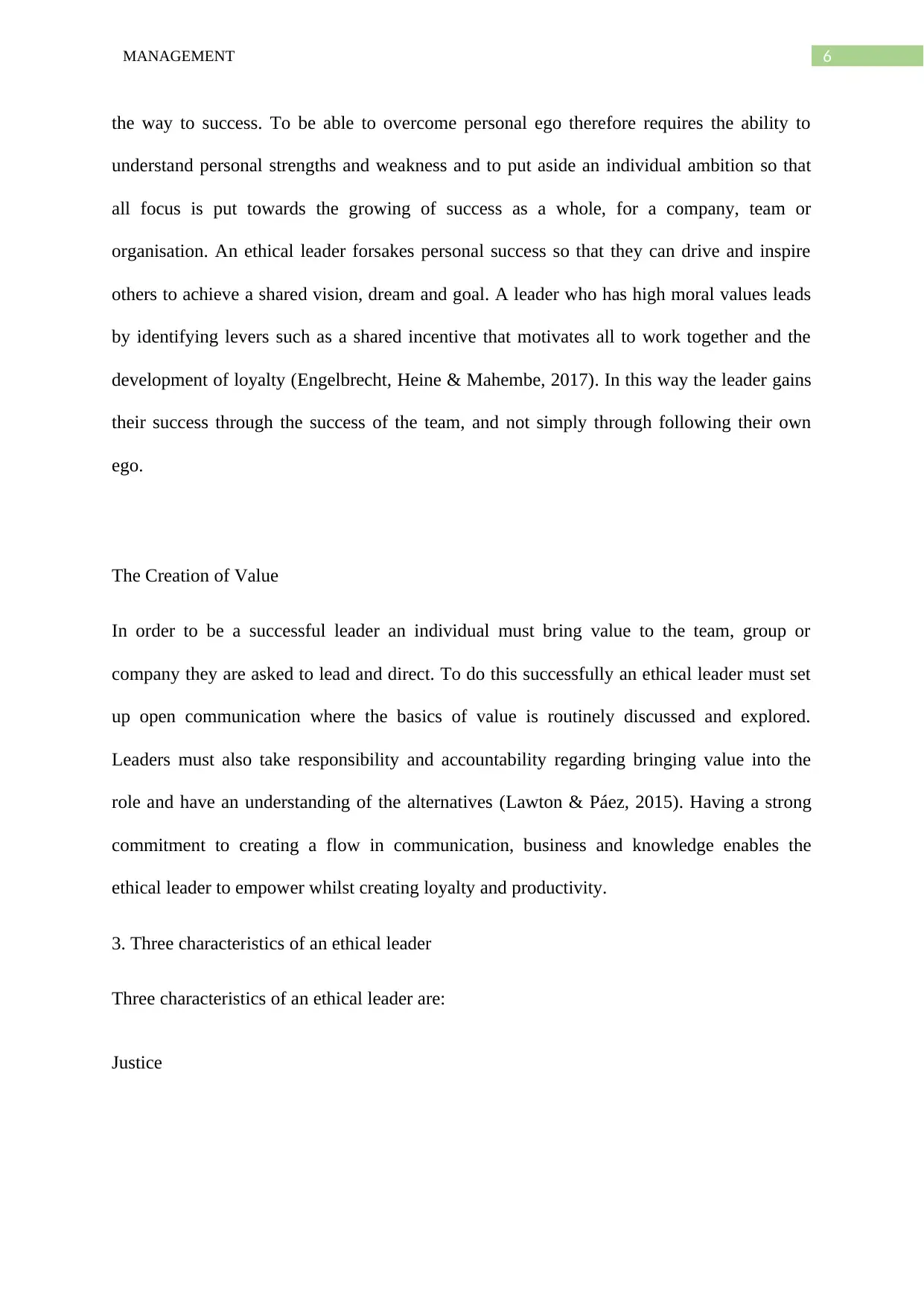
6MANAGEMENT
the way to success. To be able to overcome personal ego therefore requires the ability to
understand personal strengths and weakness and to put aside an individual ambition so that
all focus is put towards the growing of success as a whole, for a company, team or
organisation. An ethical leader forsakes personal success so that they can drive and inspire
others to achieve a shared vision, dream and goal. A leader who has high moral values leads
by identifying levers such as a shared incentive that motivates all to work together and the
development of loyalty (Engelbrecht, Heine & Mahembe, 2017). In this way the leader gains
their success through the success of the team, and not simply through following their own
ego.
The Creation of Value
In order to be a successful leader an individual must bring value to the team, group or
company they are asked to lead and direct. To do this successfully an ethical leader must set
up open communication where the basics of value is routinely discussed and explored.
Leaders must also take responsibility and accountability regarding bringing value into the
role and have an understanding of the alternatives (Lawton & Páez, 2015). Having a strong
commitment to creating a flow in communication, business and knowledge enables the
ethical leader to empower whilst creating loyalty and productivity.
3. Three characteristics of an ethical leader
Three characteristics of an ethical leader are:
Justice
the way to success. To be able to overcome personal ego therefore requires the ability to
understand personal strengths and weakness and to put aside an individual ambition so that
all focus is put towards the growing of success as a whole, for a company, team or
organisation. An ethical leader forsakes personal success so that they can drive and inspire
others to achieve a shared vision, dream and goal. A leader who has high moral values leads
by identifying levers such as a shared incentive that motivates all to work together and the
development of loyalty (Engelbrecht, Heine & Mahembe, 2017). In this way the leader gains
their success through the success of the team, and not simply through following their own
ego.
The Creation of Value
In order to be a successful leader an individual must bring value to the team, group or
company they are asked to lead and direct. To do this successfully an ethical leader must set
up open communication where the basics of value is routinely discussed and explored.
Leaders must also take responsibility and accountability regarding bringing value into the
role and have an understanding of the alternatives (Lawton & Páez, 2015). Having a strong
commitment to creating a flow in communication, business and knowledge enables the
ethical leader to empower whilst creating loyalty and productivity.
3. Three characteristics of an ethical leader
Three characteristics of an ethical leader are:
Justice
⊘ This is a preview!⊘
Do you want full access?
Subscribe today to unlock all pages.

Trusted by 1+ million students worldwide
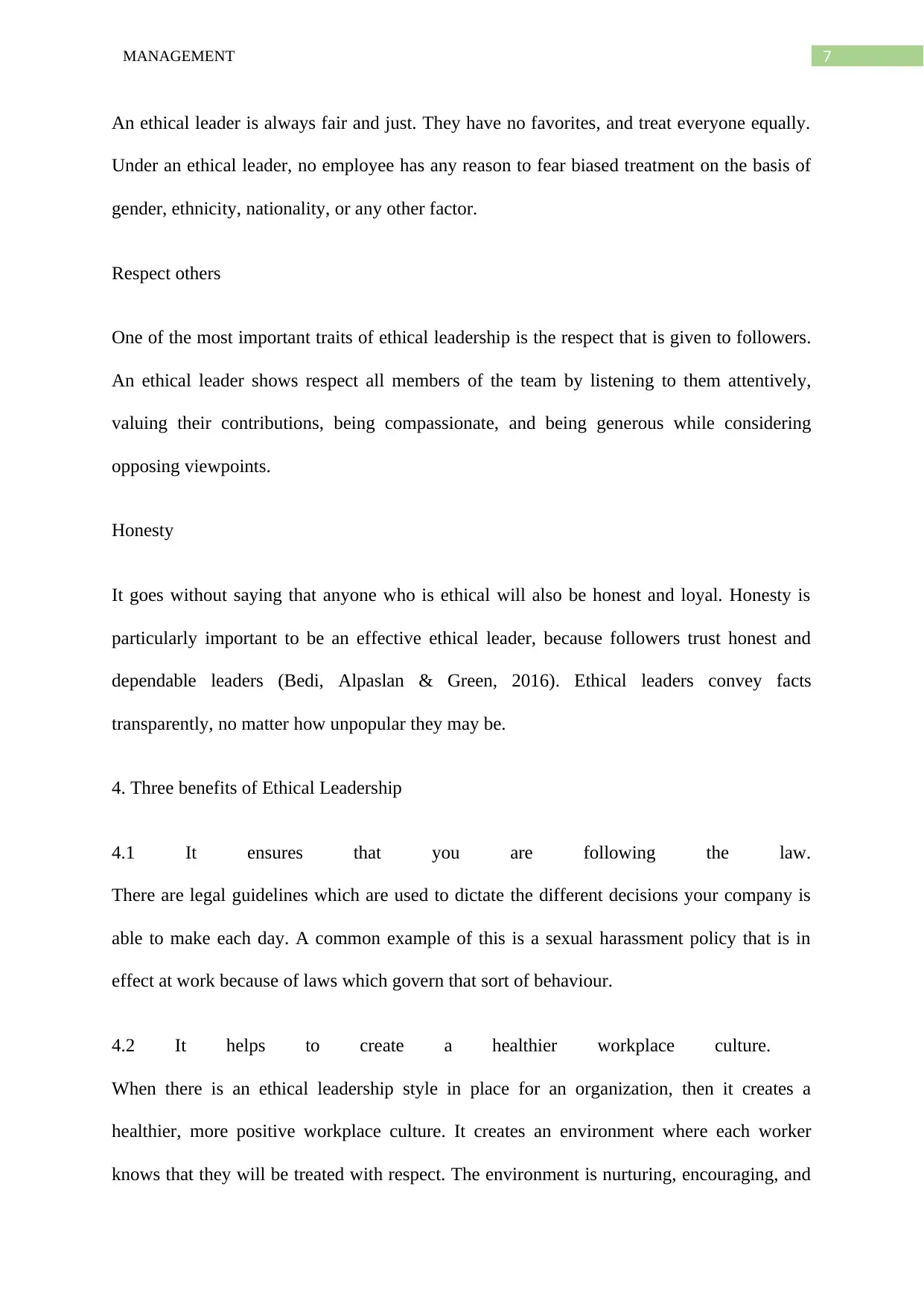
7MANAGEMENT
An ethical leader is always fair and just. They have no favorites, and treat everyone equally.
Under an ethical leader, no employee has any reason to fear biased treatment on the basis of
gender, ethnicity, nationality, or any other factor.
Respect others
One of the most important traits of ethical leadership is the respect that is given to followers.
An ethical leader shows respect all members of the team by listening to them attentively,
valuing their contributions, being compassionate, and being generous while considering
opposing viewpoints.
Honesty
It goes without saying that anyone who is ethical will also be honest and loyal. Honesty is
particularly important to be an effective ethical leader, because followers trust honest and
dependable leaders (Bedi, Alpaslan & Green, 2016). Ethical leaders convey facts
transparently, no matter how unpopular they may be.
4. Three benefits of Ethical Leadership
4.1 It ensures that you are following the law.
There are legal guidelines which are used to dictate the different decisions your company is
able to make each day. A common example of this is a sexual harassment policy that is in
effect at work because of laws which govern that sort of behaviour.
4.2 It helps to create a healthier workplace culture.
When there is an ethical leadership style in place for an organization, then it creates a
healthier, more positive workplace culture. It creates an environment where each worker
knows that they will be treated with respect. The environment is nurturing, encouraging, and
An ethical leader is always fair and just. They have no favorites, and treat everyone equally.
Under an ethical leader, no employee has any reason to fear biased treatment on the basis of
gender, ethnicity, nationality, or any other factor.
Respect others
One of the most important traits of ethical leadership is the respect that is given to followers.
An ethical leader shows respect all members of the team by listening to them attentively,
valuing their contributions, being compassionate, and being generous while considering
opposing viewpoints.
Honesty
It goes without saying that anyone who is ethical will also be honest and loyal. Honesty is
particularly important to be an effective ethical leader, because followers trust honest and
dependable leaders (Bedi, Alpaslan & Green, 2016). Ethical leaders convey facts
transparently, no matter how unpopular they may be.
4. Three benefits of Ethical Leadership
4.1 It ensures that you are following the law.
There are legal guidelines which are used to dictate the different decisions your company is
able to make each day. A common example of this is a sexual harassment policy that is in
effect at work because of laws which govern that sort of behaviour.
4.2 It helps to create a healthier workplace culture.
When there is an ethical leadership style in place for an organization, then it creates a
healthier, more positive workplace culture. It creates an environment where each worker
knows that they will be treated with respect. The environment is nurturing, encouraging, and
Paraphrase This Document
Need a fresh take? Get an instant paraphrase of this document with our AI Paraphraser
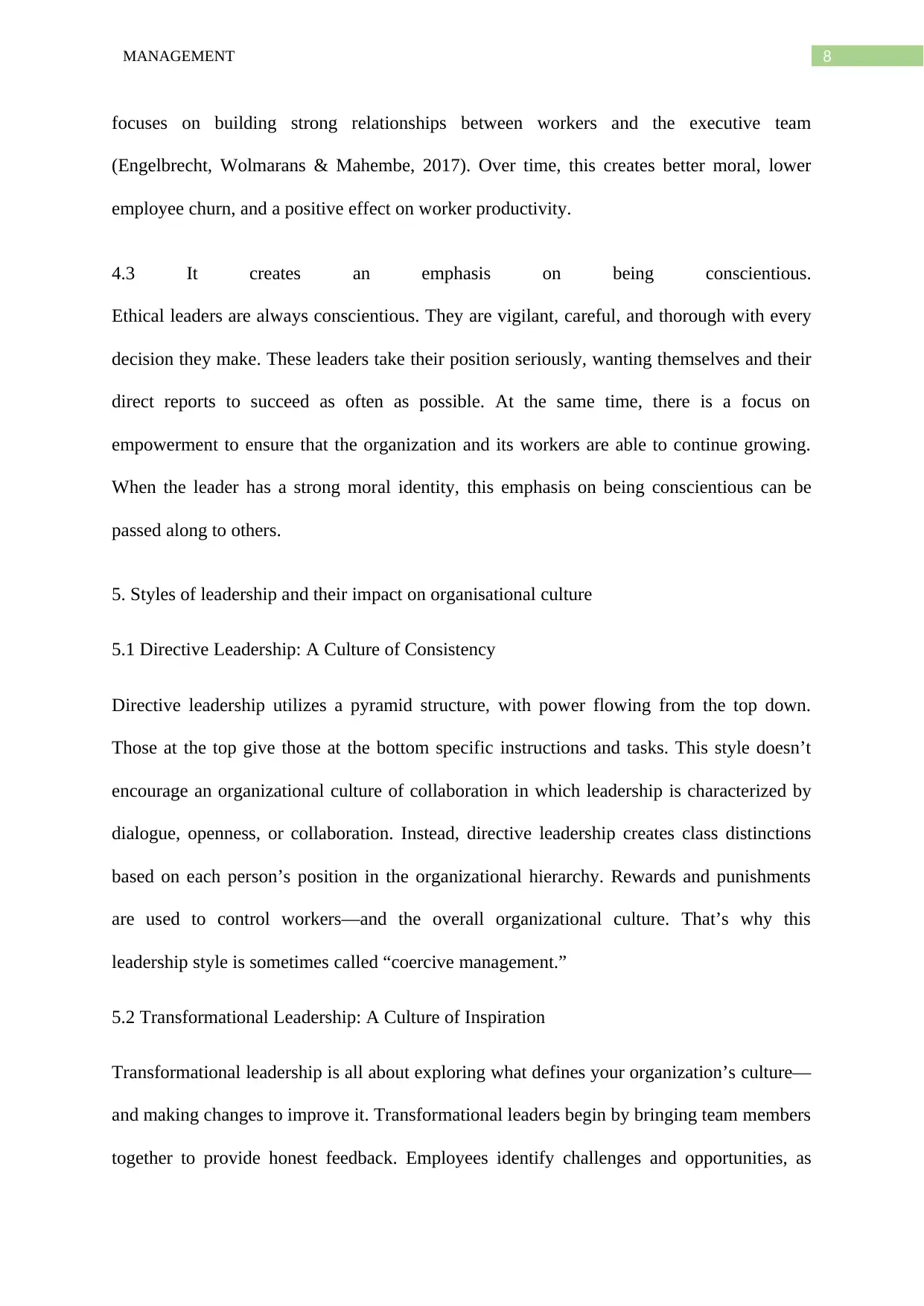
8MANAGEMENT
focuses on building strong relationships between workers and the executive team
(Engelbrecht, Wolmarans & Mahembe, 2017). Over time, this creates better moral, lower
employee churn, and a positive effect on worker productivity.
4.3 It creates an emphasis on being conscientious.
Ethical leaders are always conscientious. They are vigilant, careful, and thorough with every
decision they make. These leaders take their position seriously, wanting themselves and their
direct reports to succeed as often as possible. At the same time, there is a focus on
empowerment to ensure that the organization and its workers are able to continue growing.
When the leader has a strong moral identity, this emphasis on being conscientious can be
passed along to others.
5. Styles of leadership and their impact on organisational culture
5.1 Directive Leadership: A Culture of Consistency
Directive leadership utilizes a pyramid structure, with power flowing from the top down.
Those at the top give those at the bottom specific instructions and tasks. This style doesn’t
encourage an organizational culture of collaboration in which leadership is characterized by
dialogue, openness, or collaboration. Instead, directive leadership creates class distinctions
based on each person’s position in the organizational hierarchy. Rewards and punishments
are used to control workers—and the overall organizational culture. That’s why this
leadership style is sometimes called “coercive management.”
5.2 Transformational Leadership: A Culture of Inspiration
Transformational leadership is all about exploring what defines your organization’s culture—
and making changes to improve it. Transformational leaders begin by bringing team members
together to provide honest feedback. Employees identify challenges and opportunities, as
focuses on building strong relationships between workers and the executive team
(Engelbrecht, Wolmarans & Mahembe, 2017). Over time, this creates better moral, lower
employee churn, and a positive effect on worker productivity.
4.3 It creates an emphasis on being conscientious.
Ethical leaders are always conscientious. They are vigilant, careful, and thorough with every
decision they make. These leaders take their position seriously, wanting themselves and their
direct reports to succeed as often as possible. At the same time, there is a focus on
empowerment to ensure that the organization and its workers are able to continue growing.
When the leader has a strong moral identity, this emphasis on being conscientious can be
passed along to others.
5. Styles of leadership and their impact on organisational culture
5.1 Directive Leadership: A Culture of Consistency
Directive leadership utilizes a pyramid structure, with power flowing from the top down.
Those at the top give those at the bottom specific instructions and tasks. This style doesn’t
encourage an organizational culture of collaboration in which leadership is characterized by
dialogue, openness, or collaboration. Instead, directive leadership creates class distinctions
based on each person’s position in the organizational hierarchy. Rewards and punishments
are used to control workers—and the overall organizational culture. That’s why this
leadership style is sometimes called “coercive management.”
5.2 Transformational Leadership: A Culture of Inspiration
Transformational leadership is all about exploring what defines your organization’s culture—
and making changes to improve it. Transformational leaders begin by bringing team members
together to provide honest feedback. Employees identify challenges and opportunities, as
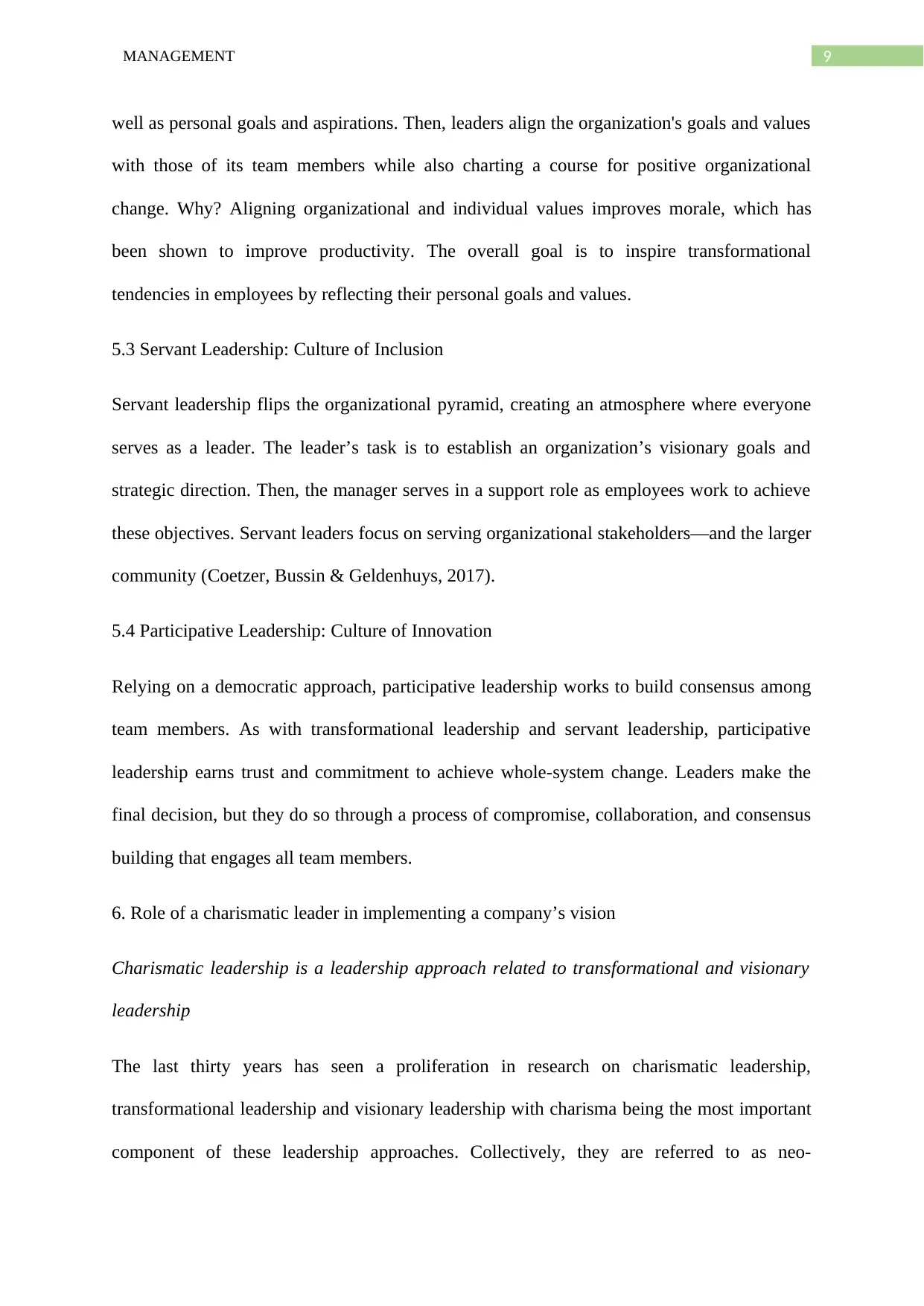
9MANAGEMENT
well as personal goals and aspirations. Then, leaders align the organization's goals and values
with those of its team members while also charting a course for positive organizational
change. Why? Aligning organizational and individual values improves morale, which has
been shown to improve productivity. The overall goal is to inspire transformational
tendencies in employees by reflecting their personal goals and values.
5.3 Servant Leadership: Culture of Inclusion
Servant leadership flips the organizational pyramid, creating an atmosphere where everyone
serves as a leader. The leader’s task is to establish an organization’s visionary goals and
strategic direction. Then, the manager serves in a support role as employees work to achieve
these objectives. Servant leaders focus on serving organizational stakeholders—and the larger
community (Coetzer, Bussin & Geldenhuys, 2017).
5.4 Participative Leadership: Culture of Innovation
Relying on a democratic approach, participative leadership works to build consensus among
team members. As with transformational leadership and servant leadership, participative
leadership earns trust and commitment to achieve whole-system change. Leaders make the
final decision, but they do so through a process of compromise, collaboration, and consensus
building that engages all team members.
6. Role of a charismatic leader in implementing a company’s vision
Charismatic leadership is a leadership approach related to transformational and visionary
leadership
The last thirty years has seen a proliferation in research on charismatic leadership,
transformational leadership and visionary leadership with charisma being the most important
component of these leadership approaches. Collectively, they are referred to as neo-
well as personal goals and aspirations. Then, leaders align the organization's goals and values
with those of its team members while also charting a course for positive organizational
change. Why? Aligning organizational and individual values improves morale, which has
been shown to improve productivity. The overall goal is to inspire transformational
tendencies in employees by reflecting their personal goals and values.
5.3 Servant Leadership: Culture of Inclusion
Servant leadership flips the organizational pyramid, creating an atmosphere where everyone
serves as a leader. The leader’s task is to establish an organization’s visionary goals and
strategic direction. Then, the manager serves in a support role as employees work to achieve
these objectives. Servant leaders focus on serving organizational stakeholders—and the larger
community (Coetzer, Bussin & Geldenhuys, 2017).
5.4 Participative Leadership: Culture of Innovation
Relying on a democratic approach, participative leadership works to build consensus among
team members. As with transformational leadership and servant leadership, participative
leadership earns trust and commitment to achieve whole-system change. Leaders make the
final decision, but they do so through a process of compromise, collaboration, and consensus
building that engages all team members.
6. Role of a charismatic leader in implementing a company’s vision
Charismatic leadership is a leadership approach related to transformational and visionary
leadership
The last thirty years has seen a proliferation in research on charismatic leadership,
transformational leadership and visionary leadership with charisma being the most important
component of these leadership approaches. Collectively, they are referred to as neo-
⊘ This is a preview!⊘
Do you want full access?
Subscribe today to unlock all pages.

Trusted by 1+ million students worldwide
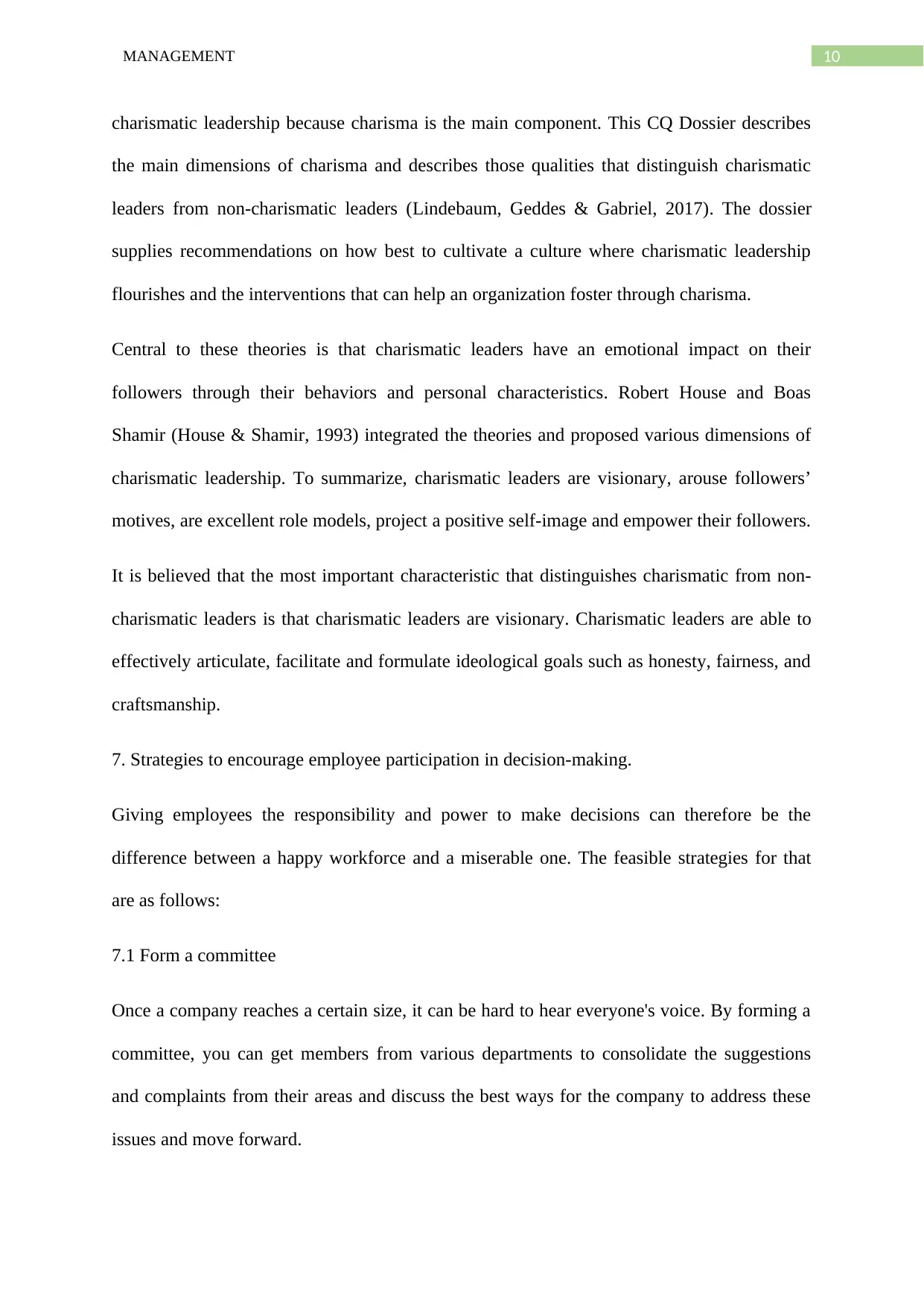
10MANAGEMENT
charismatic leadership because charisma is the main component. This CQ Dossier describes
the main dimensions of charisma and describes those qualities that distinguish charismatic
leaders from non-charismatic leaders (Lindebaum, Geddes & Gabriel, 2017). The dossier
supplies recommendations on how best to cultivate a culture where charismatic leadership
flourishes and the interventions that can help an organization foster through charisma.
Central to these theories is that charismatic leaders have an emotional impact on their
followers through their behaviors and personal characteristics. Robert House and Boas
Shamir (House & Shamir, 1993) integrated the theories and proposed various dimensions of
charismatic leadership. To summarize, charismatic leaders are visionary, arouse followers’
motives, are excellent role models, project a positive self-image and empower their followers.
It is believed that the most important characteristic that distinguishes charismatic from non-
charismatic leaders is that charismatic leaders are visionary. Charismatic leaders are able to
effectively articulate, facilitate and formulate ideological goals such as honesty, fairness, and
craftsmanship.
7. Strategies to encourage employee participation in decision-making.
Giving employees the responsibility and power to make decisions can therefore be the
difference between a happy workforce and a miserable one. The feasible strategies for that
are as follows:
7.1 Form a committee
Once a company reaches a certain size, it can be hard to hear everyone's voice. By forming a
committee, you can get members from various departments to consolidate the suggestions
and complaints from their areas and discuss the best ways for the company to address these
issues and move forward.
charismatic leadership because charisma is the main component. This CQ Dossier describes
the main dimensions of charisma and describes those qualities that distinguish charismatic
leaders from non-charismatic leaders (Lindebaum, Geddes & Gabriel, 2017). The dossier
supplies recommendations on how best to cultivate a culture where charismatic leadership
flourishes and the interventions that can help an organization foster through charisma.
Central to these theories is that charismatic leaders have an emotional impact on their
followers through their behaviors and personal characteristics. Robert House and Boas
Shamir (House & Shamir, 1993) integrated the theories and proposed various dimensions of
charismatic leadership. To summarize, charismatic leaders are visionary, arouse followers’
motives, are excellent role models, project a positive self-image and empower their followers.
It is believed that the most important characteristic that distinguishes charismatic from non-
charismatic leaders is that charismatic leaders are visionary. Charismatic leaders are able to
effectively articulate, facilitate and formulate ideological goals such as honesty, fairness, and
craftsmanship.
7. Strategies to encourage employee participation in decision-making.
Giving employees the responsibility and power to make decisions can therefore be the
difference between a happy workforce and a miserable one. The feasible strategies for that
are as follows:
7.1 Form a committee
Once a company reaches a certain size, it can be hard to hear everyone's voice. By forming a
committee, you can get members from various departments to consolidate the suggestions
and complaints from their areas and discuss the best ways for the company to address these
issues and move forward.
Paraphrase This Document
Need a fresh take? Get an instant paraphrase of this document with our AI Paraphraser
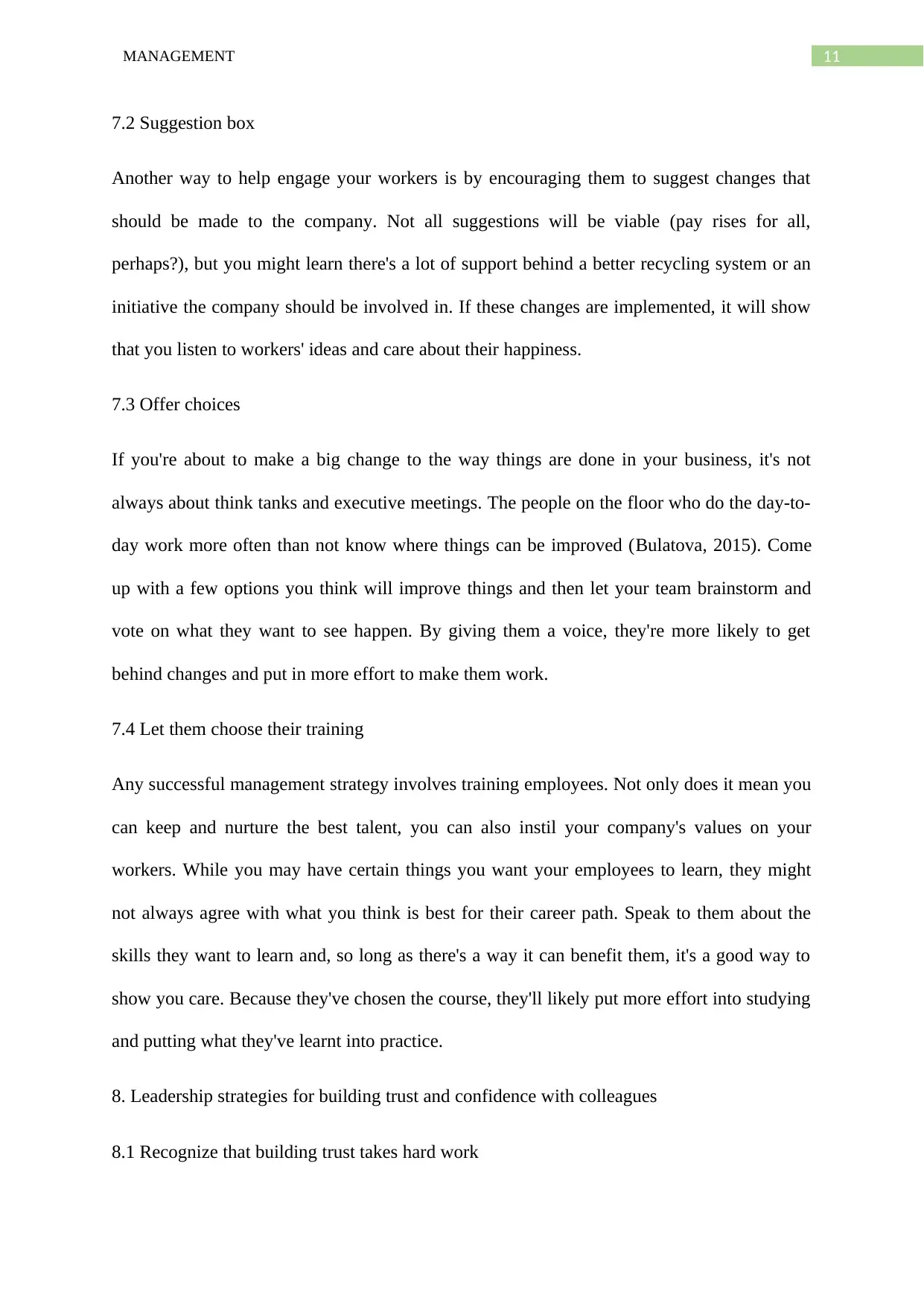
11MANAGEMENT
7.2 Suggestion box
Another way to help engage your workers is by encouraging them to suggest changes that
should be made to the company. Not all suggestions will be viable (pay rises for all,
perhaps?), but you might learn there's a lot of support behind a better recycling system or an
initiative the company should be involved in. If these changes are implemented, it will show
that you listen to workers' ideas and care about their happiness.
7.3 Offer choices
If you're about to make a big change to the way things are done in your business, it's not
always about think tanks and executive meetings. The people on the floor who do the day-to-
day work more often than not know where things can be improved (Bulatova, 2015). Come
up with a few options you think will improve things and then let your team brainstorm and
vote on what they want to see happen. By giving them a voice, they're more likely to get
behind changes and put in more effort to make them work.
7.4 Let them choose their training
Any successful management strategy involves training employees. Not only does it mean you
can keep and nurture the best talent, you can also instil your company's values on your
workers. While you may have certain things you want your employees to learn, they might
not always agree with what you think is best for their career path. Speak to them about the
skills they want to learn and, so long as there's a way it can benefit them, it's a good way to
show you care. Because they've chosen the course, they'll likely put more effort into studying
and putting what they've learnt into practice.
8. Leadership strategies for building trust and confidence with colleagues
8.1 Recognize that building trust takes hard work
7.2 Suggestion box
Another way to help engage your workers is by encouraging them to suggest changes that
should be made to the company. Not all suggestions will be viable (pay rises for all,
perhaps?), but you might learn there's a lot of support behind a better recycling system or an
initiative the company should be involved in. If these changes are implemented, it will show
that you listen to workers' ideas and care about their happiness.
7.3 Offer choices
If you're about to make a big change to the way things are done in your business, it's not
always about think tanks and executive meetings. The people on the floor who do the day-to-
day work more often than not know where things can be improved (Bulatova, 2015). Come
up with a few options you think will improve things and then let your team brainstorm and
vote on what they want to see happen. By giving them a voice, they're more likely to get
behind changes and put in more effort to make them work.
7.4 Let them choose their training
Any successful management strategy involves training employees. Not only does it mean you
can keep and nurture the best talent, you can also instil your company's values on your
workers. While you may have certain things you want your employees to learn, they might
not always agree with what you think is best for their career path. Speak to them about the
skills they want to learn and, so long as there's a way it can benefit them, it's a good way to
show you care. Because they've chosen the course, they'll likely put more effort into studying
and putting what they've learnt into practice.
8. Leadership strategies for building trust and confidence with colleagues
8.1 Recognize that building trust takes hard work
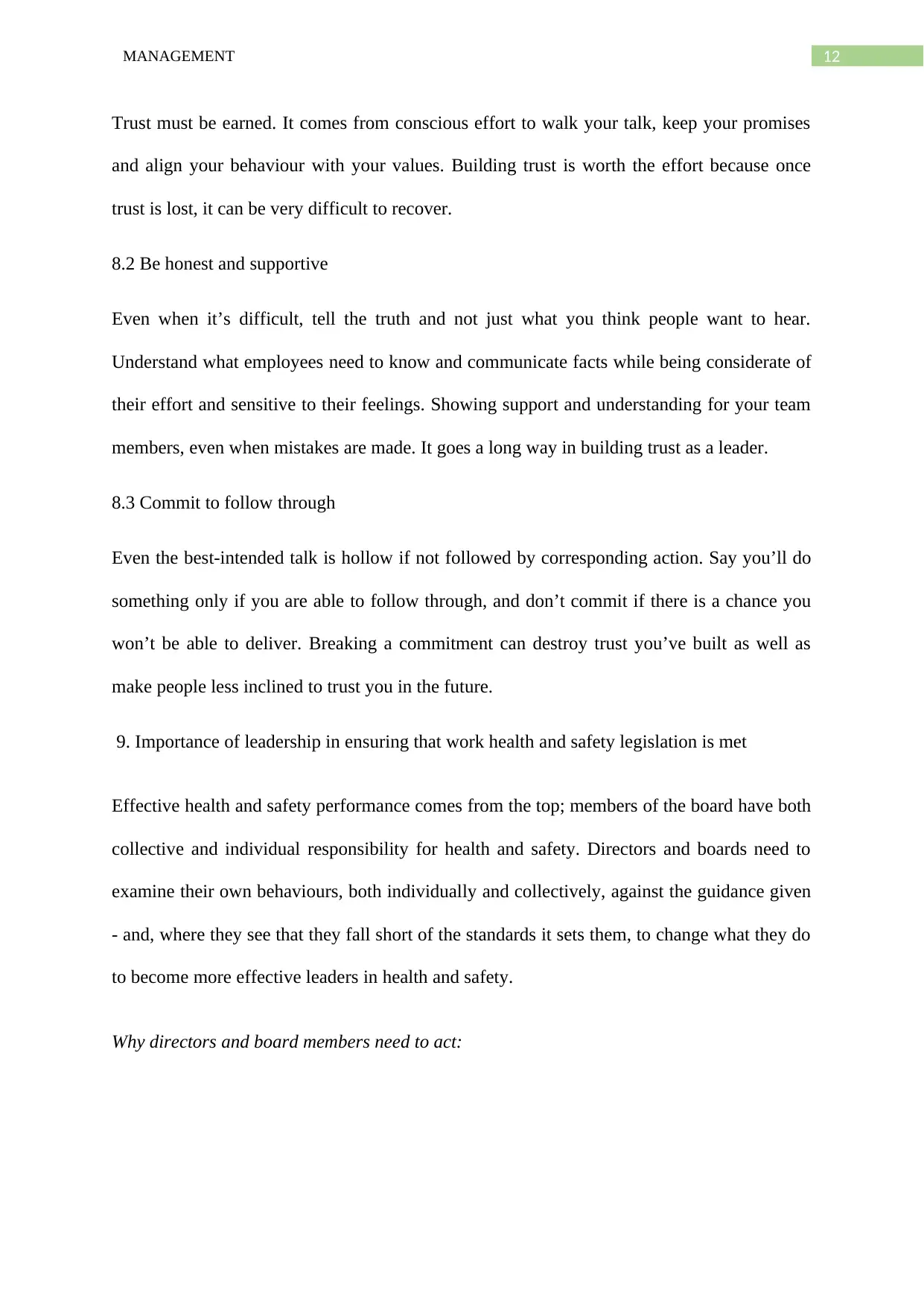
12MANAGEMENT
Trust must be earned. It comes from conscious effort to walk your talk, keep your promises
and align your behaviour with your values. Building trust is worth the effort because once
trust is lost, it can be very difficult to recover.
8.2 Be honest and supportive
Even when it’s difficult, tell the truth and not just what you think people want to hear.
Understand what employees need to know and communicate facts while being considerate of
their effort and sensitive to their feelings. Showing support and understanding for your team
members, even when mistakes are made. It goes a long way in building trust as a leader.
8.3 Commit to follow through
Even the best-intended talk is hollow if not followed by corresponding action. Say you’ll do
something only if you are able to follow through, and don’t commit if there is a chance you
won’t be able to deliver. Breaking a commitment can destroy trust you’ve built as well as
make people less inclined to trust you in the future.
9. Importance of leadership in ensuring that work health and safety legislation is met
Effective health and safety performance comes from the top; members of the board have both
collective and individual responsibility for health and safety. Directors and boards need to
examine their own behaviours, both individually and collectively, against the guidance given
- and, where they see that they fall short of the standards it sets them, to change what they do
to become more effective leaders in health and safety.
Why directors and board members need to act:
Trust must be earned. It comes from conscious effort to walk your talk, keep your promises
and align your behaviour with your values. Building trust is worth the effort because once
trust is lost, it can be very difficult to recover.
8.2 Be honest and supportive
Even when it’s difficult, tell the truth and not just what you think people want to hear.
Understand what employees need to know and communicate facts while being considerate of
their effort and sensitive to their feelings. Showing support and understanding for your team
members, even when mistakes are made. It goes a long way in building trust as a leader.
8.3 Commit to follow through
Even the best-intended talk is hollow if not followed by corresponding action. Say you’ll do
something only if you are able to follow through, and don’t commit if there is a chance you
won’t be able to deliver. Breaking a commitment can destroy trust you’ve built as well as
make people less inclined to trust you in the future.
9. Importance of leadership in ensuring that work health and safety legislation is met
Effective health and safety performance comes from the top; members of the board have both
collective and individual responsibility for health and safety. Directors and boards need to
examine their own behaviours, both individually and collectively, against the guidance given
- and, where they see that they fall short of the standards it sets them, to change what they do
to become more effective leaders in health and safety.
Why directors and board members need to act:
⊘ This is a preview!⊘
Do you want full access?
Subscribe today to unlock all pages.

Trusted by 1+ million students worldwide
1 out of 43
Related Documents
Your All-in-One AI-Powered Toolkit for Academic Success.
+13062052269
info@desklib.com
Available 24*7 on WhatsApp / Email
![[object Object]](/_next/static/media/star-bottom.7253800d.svg)
Unlock your academic potential
Copyright © 2020–2025 A2Z Services. All Rights Reserved. Developed and managed by ZUCOL.


